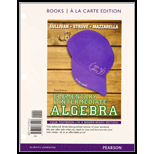
Elementary & Intermediate Algebra with Access Code
3rd Edition
ISBN: 9780321915139
Author: Michael III Sullivan
Publisher: PEARSON
expand_more
expand_more
format_list_bulleted
Concept explainers
Textbook Question
Chapter A, Problem 14E
In Problems 9-22, divide using synthetic division. See Objective 1.
14.
Expert Solution & Answer
Want to see the full answer?
Check out a sample textbook solution
Students have asked these similar questions
A research study in the year 2009 found that there were 2760 coyotes
in a given region. The coyote population declined at a rate of 5.8%
each year.
How many fewer coyotes were there in 2024 than in 2015?
Explain in at least one sentence how you solved the problem. Show
your work. Round your answer to the nearest whole number.
Answer the following questions related to the following matrix
A =
3
³).
Explain the following terms
Chapter A Solutions
Elementary & Intermediate Algebra with Access Code
Ch. A - True or False We can divide 4x3 + 5x2 + 10x 3 by...Ch. A - Prob. 2ECh. A - Prob. 3ECh. A - Prob. 4ECh. A - Prob. 5ECh. A - Prob. 6ECh. A - Prob. 7ECh. A - Prob. 8ECh. A - Prob. 9ECh. A - In Problems 9-22, divide using synthetic division....
Ch. A - Prob. 11ECh. A - In Problems 9-22, divide using synthetic division....Ch. A - Prob. 13ECh. A - In Problems 9-22, divide using synthetic division....Ch. A - Prob. 15ECh. A - In Problems 9-22, divide using synthetic division....Ch. A - Prob. 17ECh. A - In Problems 9-22, divide using synthetic division....Ch. A - Prob. 19ECh. A - Prob. 20ECh. A - Prob. 21ECh. A - Prob. 22ECh. A - Prob. 23ECh. A - In Problems 23-30, use the Remainder Theorem to...Ch. A - Prob. 25ECh. A - In Problems 23-30, use the Remainder Theorem to...Ch. A - Prob. 27ECh. A - In Problems 23-30, use the Remainder Theorem to...Ch. A - Prob. 29ECh. A - In Problems 23-30, use the Remainder Theorem to...Ch. A - Prob. 31ECh. A - Prob. 32ECh. A - Prob. 33ECh. A - Prob. 34ECh. A - Prob. 35ECh. A - Prob. 36ECh. A - Prob. 37ECh. A - Prob. 38ECh. A - Prob. 39ECh. A - Prob. 40ECh. A - Prob. 41ECh. A - Prob. 42ECh. A - Prob. 43ECh. A - Prob. 44ECh. A - If f is a polynomial of degree n and it is divided...Ch. A - Prob. 46ECh. A - Prob. 47E
Additional Math Textbook Solutions
Find more solutions based on key concepts
1. How much money is Joe earning when he’s 30?
Pathways To Math Literacy (looseleaf)
For Problems 23-28, write in simpler form, as in Example 4. logbFG
Finite Mathematics for Business, Economics, Life Sciences and Social Sciences
1. How is a sample related to a population?
Elementary Statistics: Picturing the World (7th Edition)
Empirical versus Theoretical A Monopoly player claims that the probability of getting a 4 when rolling a six-si...
Introductory Statistics
First Derivative Test a. Locale the critical points of f. b. Use the First Derivative Test to locale the local ...
Calculus: Early Transcendentals (2nd Edition)
23. A plant nursery sells two sizes of oak trees to landscapers. Large trees cost the nursery $120 from the gro...
College Algebra (Collegiate Math)
Knowledge Booster
Learn more about
Need a deep-dive on the concept behind this application? Look no further. Learn more about this topic, algebra and related others by exploring similar questions and additional content below.Similar questions
- Solve questions by Course Name (Ordinary Differential Equations II 2)arrow_forwardplease Solve questions by Course Name( Ordinary Differential Equations II 2)arrow_forwardInThe Northern Lights are bright flashes of colored light between 50 and 200 miles above Earth. Suppose a flash occurs 150 miles above Earth. What is the measure of arc BD, the portion of Earth from which the flash is visible? (Earth’s radius is approximately 4000 miles.)arrow_forward
- e). n! (n - 1)!arrow_forwardSuppose you flip a fair two-sided coin four times and record the result. a). List the sample space of this experiment. That is, list all possible outcomes that could occur when flipping a fair two-sided coin four total times. Assume the two sides of the coin are Heads (H) and Tails (T).arrow_forwarde). n! (n - 1)!arrow_forward
- Evaluate the following expression and show your work to support your calculations. a). 6! b). 4! 3!0! 7! c). 5!2! d). 5!2! e). n! (n - 1)!arrow_forwardAmy and Samiha have a hat that contains two playing cards, one ace and one king. They are playing a game where they randomly pick a card out of the hat four times, with replacement. Amy thinks that the probability of getting exactly two aces in four picks is equal to the probability of not getting exactly two aces in four picks. Samiha disagrees. She thinks that the probability of not getting exactly two aces is greater. The sample space of possible outcomes is listed below. A represents an ace, and K represents a king. Who is correct?arrow_forwardConsider the exponential function f(x) = 12x. Complete the sentences about the key features of the graph. The domain is all real numbers. The range is y> 0. The equation of the asymptote is y = 0 The y-intercept is 1arrow_forward
arrow_back_ios
SEE MORE QUESTIONS
arrow_forward_ios
Recommended textbooks for you

 Algebra for College StudentsAlgebraISBN:9781285195780Author:Jerome E. Kaufmann, Karen L. SchwittersPublisher:Cengage Learning
Algebra for College StudentsAlgebraISBN:9781285195780Author:Jerome E. Kaufmann, Karen L. SchwittersPublisher:Cengage Learning Intermediate AlgebraAlgebraISBN:9781285195728Author:Jerome E. Kaufmann, Karen L. SchwittersPublisher:Cengage Learning
Intermediate AlgebraAlgebraISBN:9781285195728Author:Jerome E. Kaufmann, Karen L. SchwittersPublisher:Cengage Learning


Algebra for College Students
Algebra
ISBN:9781285195780
Author:Jerome E. Kaufmann, Karen L. Schwitters
Publisher:Cengage Learning

Intermediate Algebra
Algebra
ISBN:9781285195728
Author:Jerome E. Kaufmann, Karen L. Schwitters
Publisher:Cengage Learning
Finding Local Maxima and Minima by Differentiation; Author: Professor Dave Explains;https://www.youtube.com/watch?v=pvLj1s7SOtk;License: Standard YouTube License, CC-BY